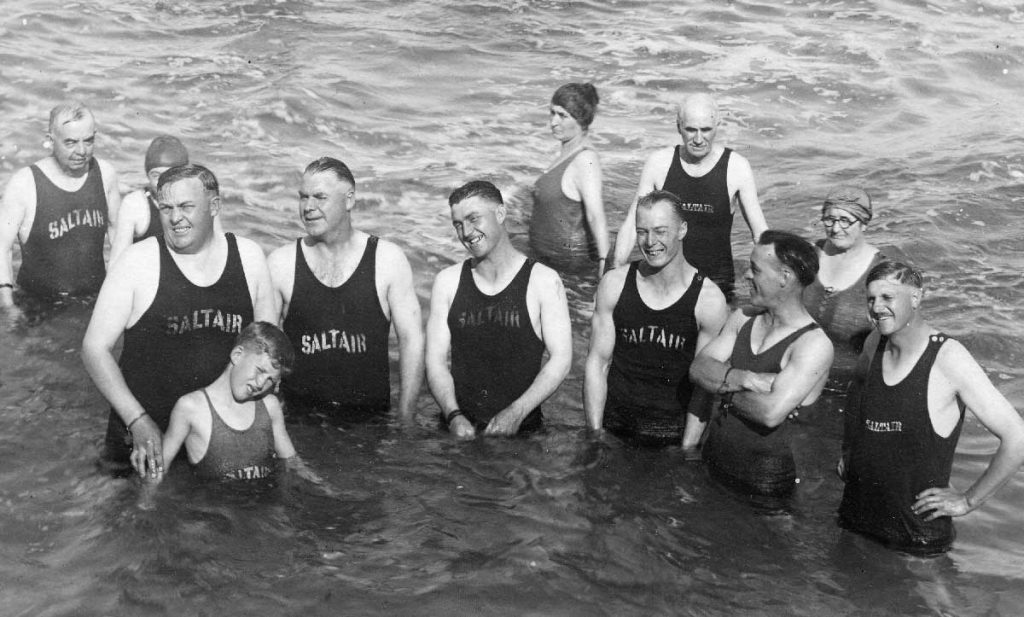Most stories written today about the Great Salt Lake have to do with its fragile ecosystem. Without intervention, whether scientific or divine, experts predict this vast body of water will dry up, threatening the health of nearby residents (who may be exposed to toxic particulate) as well as the survival of briny shrimp and millions of migratory birds. Of course, the lake is also home to a lucrative mineral extraction business that will evaporate as well.
Although it might be hard to imagine now, in the late 1800s the Great Salt Lake became a premier destination for those looking to enjoy a day at the beach followed by an evening of dining and dancing. For decades, Parkites flocked to its shores to bask in the sun and bob in the salty water. The buoyancy of the water meant one could float without effort and therefore did not need to know how to swim. People enjoyed the lake for recreation and believed that immersing themselves in the lake could provide relief from rheumatism and nervous disorders.
The Great Salt Lake was home to eight bathing resorts on its southern and eastern shores between 1870 and 1893. The first two resorts were Lake Side and Lake Shore, built in 1870. On the eastern shore approximately 13 miles from Ogden, a resort named Syracuse became the largest dancing pavilion and bathing resort in Utah when it opened on July 4, 1887. An advertisement ran in the Park Record proclaiming, “Park City people are especially invited” to visit Syracuse on July 17. The advertisement detailed the train schedule and the band lineup for the day; the price was $2.00. Given the length of time it would have taken to travel by wagon, railroads were the preferred mode of transportation.
On Memorial Day 1893, Saltair opened on the southern shore of the lake. Financed by the Mormon church, Saltair eclipsed all other resorts to become the largest and most popular on the shores of the Great Salt Lake. It was often described as the Coney Island of the West, only more wholesome. In addition to aquatic recreation, Saltair claimed to have the largest dance floor in the world, accommodating as many as 5,000 people at once. The resort also operated an amusement park, hosted rodeos, bullfights and boat rides, and showcased fireworks at night.

Credit: Park City Historical Society & Museum, Himes-Buck Digital Collection
In August 1893, the local chapter of the International Order of Odd Fellows arranged an outing from Park City to Saltair, securing a special train for the occasion. An advertisement in the Park Record stated: “The Odd Fellows of this city mean to have a strong representation at that famous resort on that day and committees are now at work making all necessary arrangements.” The Odd Fellows excursion was well received and became an annual affair. Other local fraternal orders such as the Park Lodge No. 4, Knights of Pythias, the Ancient Order of the Hibernians, and the Woodmen of the World soon followed suit, promoting their own trips. As competition among the fraternal orders heated up, prices declined. Excursions from Park City to Saltair that were initially priced at steeper fares quickly stabilized at $1.50 per adult for a round trip. For comparison, a $1.50 ticket in the early 1900s would cost approximately $50 today.
By the 1920s, Park City merchants, service providers, social clubs, and groups of friends were organizing their own trips to Saltair. With private automobile ownership on the rise, smaller and more spontaneous excursions became accessible. The Park Record is rife with stories of “jolly” residents organizing their own daytrips to Saltair.
Of the eight lakeside resorts on the shores of the Great Salt Lake in the late 1800s, only Saltair survived past the early 1900s. One of the resorts relocated to a freshwater lake and operates today as Lagoon Amusement Park; another was lost entirely to fire. If they had still been in operation in the late 1890s half of these resorts would have fallen victim to receding waters. Most, however, were simply lost in the shadow of a grander resort.
The Park City Museum is hosting a lecture called “Historical Archaeology of Great Salt Lake” given by Dr. Chris Merritt, an archaeologist and historian with the Utah State Historic Preservation Office, on Wednesday, April 19 from 5-6 p.m. at the Park City Museum Education and Collections Center located at 2079 Sidewinder Drive.